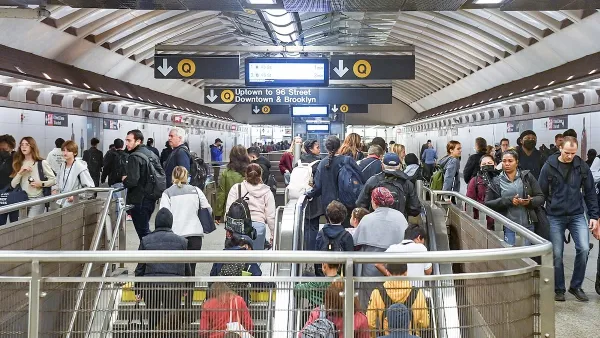The uncompromising writer, who pioneered the position of full-time architecture critic at an American newspaper, and exemplified the pinnacle of the profession for five decades, died on Monday.
Before Huxtable started at The New York Times in 1963, there had never before been a full-time architecture critic for a general-interest newspaper in the U.S. And over the next five decades of fearless criticism, she "opened the priestly precincts of design and planning to everyday readers," said David W. Dunlap in a Times obituary. "For that, she won the first Pulitzer Prize for distinguished criticism, in 1970. More recently, she was the architecture critic of The Wall Street Journal."
“'Mrs. Huxtable invented a new profession,' a valedictory Times editorial said in 1981, just as she was leaving the newspaper, 'and, quite simply, changed the way most of us see and think about man-made environments.'”
"Though knowledgeable about architectural styles," added Dunlap, "Ms. Huxtable often seemed more interested in social substance. She invited readers to consider a building not as an assembly of pilasters and entablatures but as a public statement whose form and placement had real consequences for its neighbors as well as its occupants."
In a tribute to the critic delivered at the Museum of the City of New York in 1996, the writer who followed her at the Times, Paul Goldberger, praised Huxtable as "more than just the most important pioneer of architectural criticism in newspapers in our time: she has been the most important figure in communicating the urgency of some kind of belief in the values of the man-made environment in our time, too. She has made people pay attention. She has made people care. She has made architecture matter in our culture in a way that it did not before her time."
Huxtable's writing was cutting and courageous till the end. Architectural criticism, and the city of New York, will be lesser in her absence.
FULL STORY: Ada Louise Huxtable, Champion of Livable Architecture, Dies at 91

Planetizen Federal Action Tracker
A weekly monitor of how Trump’s orders and actions are impacting planners and planning in America.

Maui's Vacation Rental Debate Turns Ugly
Verbal attacks, misinformation campaigns and fistfights plague a high-stakes debate to convert thousands of vacation rentals into long-term housing.

San Francisco Suspends Traffic Calming Amidst Record Deaths
Citing “a challenging fiscal landscape,” the city will cease the program on the heels of 42 traffic deaths, including 24 pedestrians.

Defunct Pittsburgh Power Plant to Become Residential Tower
A decommissioned steam heat plant will be redeveloped into almost 100 affordable housing units.

Trump Prompts Restructuring of Transportation Research Board in “Unprecedented Overreach”
The TRB has eliminated more than half of its committees including those focused on climate, equity, and cities.

Amtrak Rolls Out New Orleans to Alabama “Mardi Gras” Train
The new service will operate morning and evening departures between Mobile and New Orleans.
Urban Design for Planners 1: Software Tools
This six-course series explores essential urban design concepts using open source software and equips planners with the tools they need to participate fully in the urban design process.
Planning for Universal Design
Learn the tools for implementing Universal Design in planning regulations.
Heyer Gruel & Associates PA
JM Goldson LLC
Custer County Colorado
City of Camden Redevelopment Agency
City of Astoria
Transportation Research & Education Center (TREC) at Portland State University
Jefferson Parish Government
Camden Redevelopment Agency
City of Claremont





























